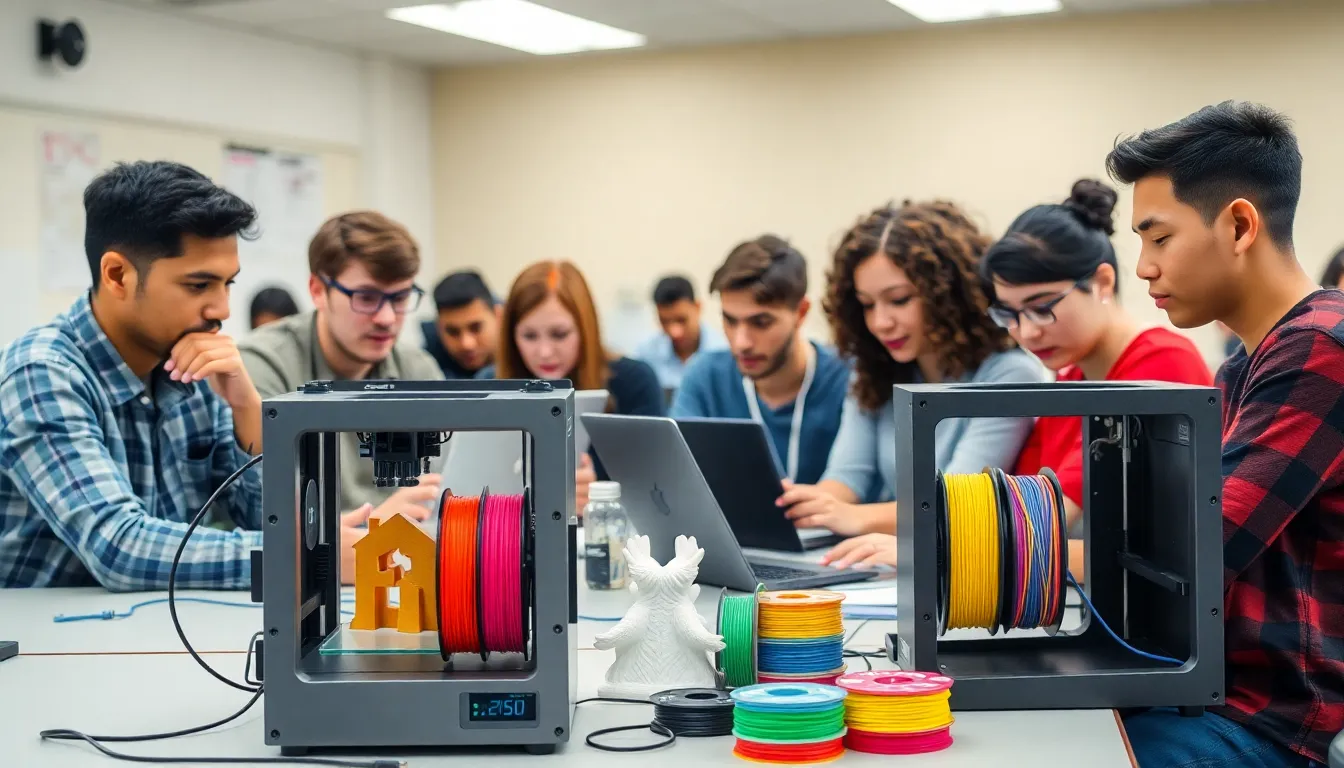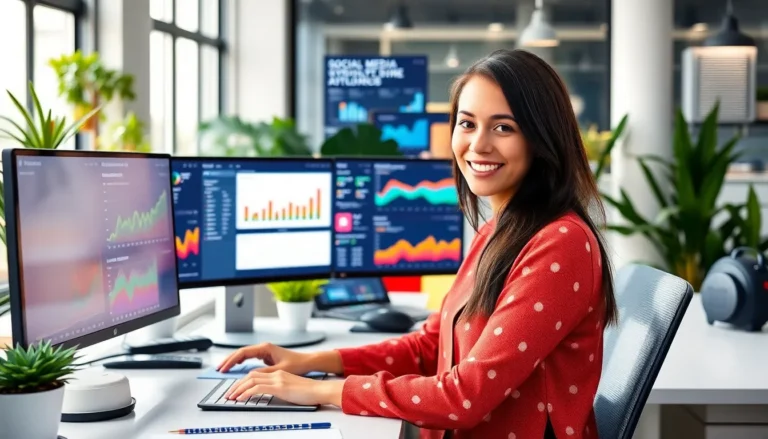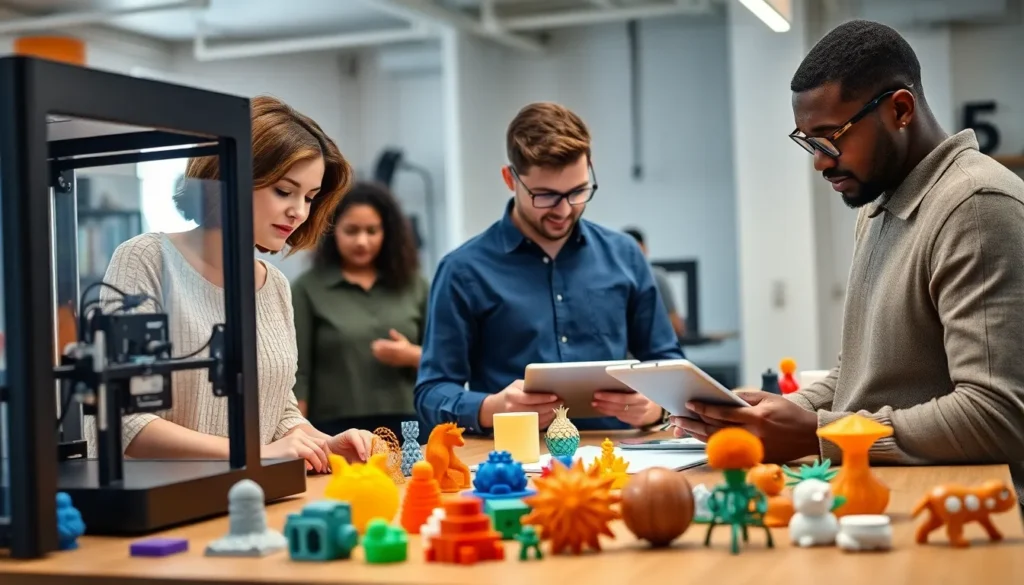Table of Contents
ToggleIn a world where creativity meets technology, 3D printing classes are the ultimate playground for aspiring inventors and hobbyists alike. Imagine transforming your wildest ideas into tangible masterpieces—without the mess of traditional sculpting. Whether it’s a quirky coffee mug or a prototype for your next big invention, these classes unlock a realm of possibilities.
Overview of 3D Printing Classes
3D printing classes provide hands-on learning experiences for individuals interested in transforming their ideas into tangible objects. Participants explore various aspects of additive manufacturing, including design principles and software tools. Instructors guide students through the entire process, from conception to production, ensuring a comprehensive understanding of the technology.
Learning opportunities vary across skill levels, ranging from beginner to advanced courses. Some classes focus on specific applications, such as prototyping for product development or creating decorative art pieces. Others emphasize the use of different materials, including plastics, metals, and even bio-based substances.
Class formats often include lectures, demonstrations, and actual printing sessions. Lectures cover the fundamentals of 3D printing, while demonstrations showcase various printers and their capabilities. During printing sessions, students apply their newfound knowledge directly, allowing them to witness their designs come to life.
Additionally, many institutions offer online courses, expanding access for learners regardless of location. These virtual formats often include interactive elements, such as Q&A sessions and community forums. Online classes also benefit those who wish to learn at their own pace.
Networking opportunities arise in these classes, connecting students with fellow enthusiasts and industry professionals. Participants often share tips, exchange resources, and collaborate on projects. Building these connections can provide valuable insights and foster long-lasting relationships in the 3D printing community.
Through 3D printing classes, individuals not only gain technical skills but also ignite their creative potential. They foster an environment that encourages experimentation and problem-solving, leading to innovative and exciting outcomes.
Benefits of Taking 3D Printing Classes

3D printing classes offer various benefits that enhance creativity and technical skills. Participants gain valuable knowledge that empowers them to design and create unique objects.
Skill Development
Skill development forms a crucial part of 3D printing classes. Students learn software programs essential for 3D modeling, such as CAD (Computer-Aided Design) tools. They explore design principles and best practices, ensuring efficient printing processes. Workshops often include practical exercises where students convert ideas into prototypes. Exposure to different materials expands their understanding of properties and applications. Personal projects challenge individuals to think critically and solve design problems. Instructors provide feedback that fosters creativity and builds confidence in technical abilities.
Career Opportunities
Taking 3D printing classes opens new career opportunities. Individuals can pursue roles in fields such as engineering, product design, and architecture. Employers increasingly seek candidates with 3D printing skills, especially in industries like manufacturing and healthcare. Participants develop a portfolio showcasing their designs, which helps in job applications. Networking events during classes connect learners with industry professionals who can provide insights and potential job leads. Career paths may extend into entrepreneurial ventures, with skills applicable to starting a business in custom product design or prototyping services.
Types of 3D Printing Classes
Different formats of 3D printing classes offer unique learning experiences. Each type has its advantages, catering to various preferences and learning styles.
In-Person Classes
In-person classes provide direct interaction with instructors and peers. These settings foster collaboration through hands-on projects and immediate feedback. Participants often benefit from guided sessions that allow them to operate printers and troubleshoot equipment on-site. Many courses include workshops where students can experiment with different materials and techniques. Engaging with fellow learners enhances the creative process, while networking opportunities can lead to valuable connections in the industry.
Online Classes
Online classes offer flexibility and convenience for learners. Participants can access course materials anytime, making it easier to balance learning with other commitments. Virtual sessions often mix pre-recorded lectures with live Q&A and interactive forums. Students explore software tools at their own pace, and many platforms include project-based assignments for practical experience. Networking within these digital communities helps students connect with industry experts and like-minded enthusiasts, expanding their professional circles.
What to Expect in a 3D Printing Class
3D printing classes offer a comprehensive experience for individuals eager to learn. Expect to engage in hands-on activities, working closely with instructors to gain valuable skills.
Course Structure
Course structure varies but typically includes a mix of lectures, demonstrations, and practical sessions. Students learn design principles before transitioning to software tools for modeling. Guided sessions follow, where they can operate printers and produce their designs. Many classes incorporate individual projects, offering opportunities for personal expression. Additionally, collaboration with peers enhances learning, allowing for shared insights and feedback. Assessments may include project presentations, which help reinforce understanding and showcase creativity.
Tools and Materials Used
Tools and materials utilized in 3D printing classes are diverse. CAD software often serves as the primary design tool, enabling students to create detailed models. Printers themselves vary in type, from FDM to SLA, each with unique properties. Students work with various materials, including PLA and ABS plastics, which help familiarize them with different properties. Metal and resin options may also be available, expanding the scope of projects. Safety equipment, such as goggles and gloves, ensures a secure learning environment. Access to these tools prepares students for real-world applications in their respective fields.
3D printing classes offer an incredible opportunity for creativity and innovation. They empower individuals to transform their ideas into physical forms while developing essential skills in design and technology. With various formats available, from in-person to online options, learners can choose what best suits their needs and schedules.
These classes not only enhance technical abilities but also foster valuable connections within the industry. As participants engage in hands-on projects and collaborate with peers, they gain insights that can lead to exciting career paths. Embracing the world of 3D printing opens doors to endless possibilities, making it an invaluable pursuit for anyone looking to explore their creative potential.







